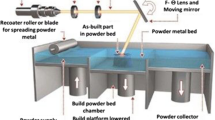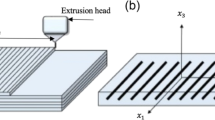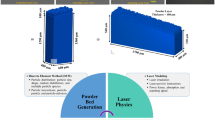Abstract
The Flexibly-reconfigurable roll forming (FRRF) scheme as one of the advanced continuous roll forming processes consists of upper and lower flexible rollers that can be controlled by each reconfigurable punch module. The shape error in the FRRF process often results in undesirable changes in the shape of the deformed surface and brings about a deviation in the precision of the deformed product. This study considers the changes in the shape error of a deformed configuration by controlling the non-uniform gap between both flexible rollers in the transverse direction. A Non-uniform rational B-spline (NURBS) type control methodology is introduced based on the transverse target curve and the thickness reduction ratio. The function for the transverse target curve is reconstructed by using a NURBS curve, and the function of the reduction ratios of the thickness is assumed to have linear increments. Finite element simulations are conducted for the FRRF process with the AA5052-H32 sheet material by applying NURBS-type control methodology for both flexible rollers. The transverse shape error of the three-dimensional surface is predicted by using a numerical approach, and its results are experimentally verified. A Reverse displacement compensation (RDC) method is adopted to compensate the transverse shape error of the deformed surface. Consequently, the proposed RDC method is validated as a suitable approach to address the transverse shape error. This method contributes to further developing capabilities to modify the profiles of the upper and lower flexible rollers in the flexibly-reconfigurable roll forming process for various 3D surface parts.
Similar content being viewed by others
References
N. Nakajima, A newly developed technique to fabricate complicated dies and electrodes with wires, Bulletin of JSME, 12 (1969) 1546–1554.
D. F. Walczyk and D. E. Hardt, Design and analysis of reconfigurable discrete dies for sheet metal forming, Journal of Manufacturing Systems, 17 (1998) 436–454.
S. C. Heo, Y. H. Seo, T. W. Ku and B. S. Kang, A study on thick plate forming using flexible forming process and its application to a simply curved plate, The International Journal of Advanced Manufacturing Technology, 51 (2010) 103–115.
S. C. Heo, Y. H. Seo, J. W. Park, T. W. Ku, J. Kim and B. S. Kang, Application of flexible forming process to hull structure forming, Journal of Mechanical Science and Technology, 24 (2010) 137–140.
G. Z. Quan, B. S. Kang, T. W. Ku and W. J. Song, Identification for the optimal working parameters of Al-Zn-Mg-Cu alloy with the processing maps based on DMM, The International Journal of Advanced Manufacturing Technology, 56 (2011) 1069–1078.
S. C. Heo, J. N. Kim, W. J. Song, T. W. Ku and B. S. Kang, Shape error compensation in flexible forming process using overbending surface method, The International Journal of Advanced Manufacturing Technology, 59 (2012) 915–928.
G. Z. Quan, T. W. Ku and B. S. Kang, Improvement of formability for multi-point bending process of AZ31B sheet material using elastic cushion, International Journal of Precision Engineering and Manufacturing, 12 (2011) 1023–1030.
L. Li, Y. H. Seo, S. C. Heo, B. S. Kang and J. Kim, Numerical simulations on reducing the unloading springback with multi-step multi-point forming technology, The International Journal of Advanced Manufacturing Technology, 48 (2010) 45–61.
S. Golabi and H. Khazaali, Determining frustum depth of 304 stainless steel plates with various diameters and thickness by incremental forming, Journal of Mechanical Science and Technology, 28 (2014) 3273–3278.
Y. H. Seo, J. W. Park, W. J. Song, B. S. Kang and J. Kim, Flexible die design and springback compensation based on modified displacement adjustment method, Advances in Mechanical Engineering, 2014 (2014) Article ID 131253.
S. J. Park, C. G. Lee, H. N. Han, S. J. Kim and K. S. Chung, Improvement of the drawability based on the surface friction stir process of AA5052-H32 automotive sheets, Metals and Materials International, 14 (2008) 47–57.
R. J. Li, M. Z. Li, N. J. Qiu and Z. Y. Cai, Surface flexible rolling for three-dimensional sheet metal parts, Journal of Materials Processing Technology, 214 (2014) 380–389.
D. M. Wang, M. Z. Li and Z. Y. Cai, Research on forming precision of flexible rolling method for three-dimensional surface parts through simulation, The International Journal of Advanced Manufacturing Technology, 71 (2014) 1717–1727.
Z. Y. Cai, M. Wang and M. Z. Li, Study on the continuous roll forming process of swept surface sheet metal part, Journal of Materials Processing Technology, 214 (2014) 1820–1827.
G, Farin, From conics to NURBS: a tutorial and survey, IEEE Computer Graphics and Applications, 12 (1992) 78–86.
O. Pekovic, S. Stupar, A. Simonovic, J. Svorcan and D. Komarov, Isogeometric bending analysis of composite plates based on a higher-order shear deformation theory, Journal of Mechanical Science and Technology, 28 (2014) 3153–3162.
J. S. Yoon, S. E. Son, W. J. Song, J. Kim and B. S. Kang, Study on flexibly-reconfigurable roll forming process for multi-curved surface of sheet metal, International Journal of Precision Engineering and Manufacturing, 15 (2014) 1069–1074.
J. S. Yoon, J. Kim, H. H. Kim and B. S. Kang, Feasibility study on flexibly reconfigurable roll forming process for sheet metal and its implementation, Advances in Mechanical Engineering, 2014 (2014) Article ID 958925.
W. Gan and R. H. Wagoner, Die design method for sheet springback, International Journal of Mechanical Sciences, 46 (2004) 1097–1113.
A. N. Karagiozis and J. G. Lenard, The effect of material properties on the coefficient of friction in cold rolling, Proc. Eurotrib, 85 (1985) 2–13.
S. W. Chen, H. M. Liu, Y. Peng and J. L. Sun, Slab analysis of large cylindrical shell rolling considering mixed friction, Journal of Mechanical Science and Technology, 28 (2015) 4753–4760.
Author information
Authors and Affiliations
Corresponding author
Additional information
Recommended by Associate Editor Dae-Cheol Ko
Pan Liu received his B.S. degree in Material Processing Engineering from Henan University of Science and Technology in 2004, and his M.S. degree in Material Processing Engineering from Chongqing University, China, in 2011. At present, he is a Ph.D. candidate of Aerospace Engineering at Pusan National University, Korea. His research interests include flexibly- reconfigurable roll forming process and multi-point dieless forming technology.
Tae-Wan Ku received his B.S., M.S. and Ph.D. degrees in Aerospace Engineering from Pusan National University, S. Korea, in 1997, 1999 and 2003, respectively. Dr. Ku is currently a professor at the ERC/ITAF (engineering research center of innovative technology on advanced forming) at Pusan National University in Busan, S. Korea. His research interests include flexibly-reconfigurable roll forming technology, tube Ubending process for steam generator, process modification of cold forging, multi-stage deep drawing and forming limit surface theory.
Beom-Soo Kang received his B.S. degree in Mechanical Engineering from Pusan National University in 1981, and his M.S. degree in Aerospace Engineering from KAIST in 1983, S. Korea. He then obtained his Ph.D. degree from the University of California at Berkeley, USA, in 1990. Dr. Kang is currently a Professor at the Department of Aerospace Engineering at Pusan National University in Busan, S. Korea. His research interests include materials processing, FEM, and flexiblyreconfigurable roll forming technology.
Rights and permissions
About this article
Cite this article
Liu, P., Ku, TW. & Kang, BS. Shape error prediction and compensation of three-dimensional surface in flexibly-reconfigurable roll forming. J Mech Sci Technol 29, 4387–4397 (2015). https://doi.org/10.1007/s12206-015-0937-9
Received:
Revised:
Accepted:
Published:
Issue Date:
DOI: https://doi.org/10.1007/s12206-015-0937-9




